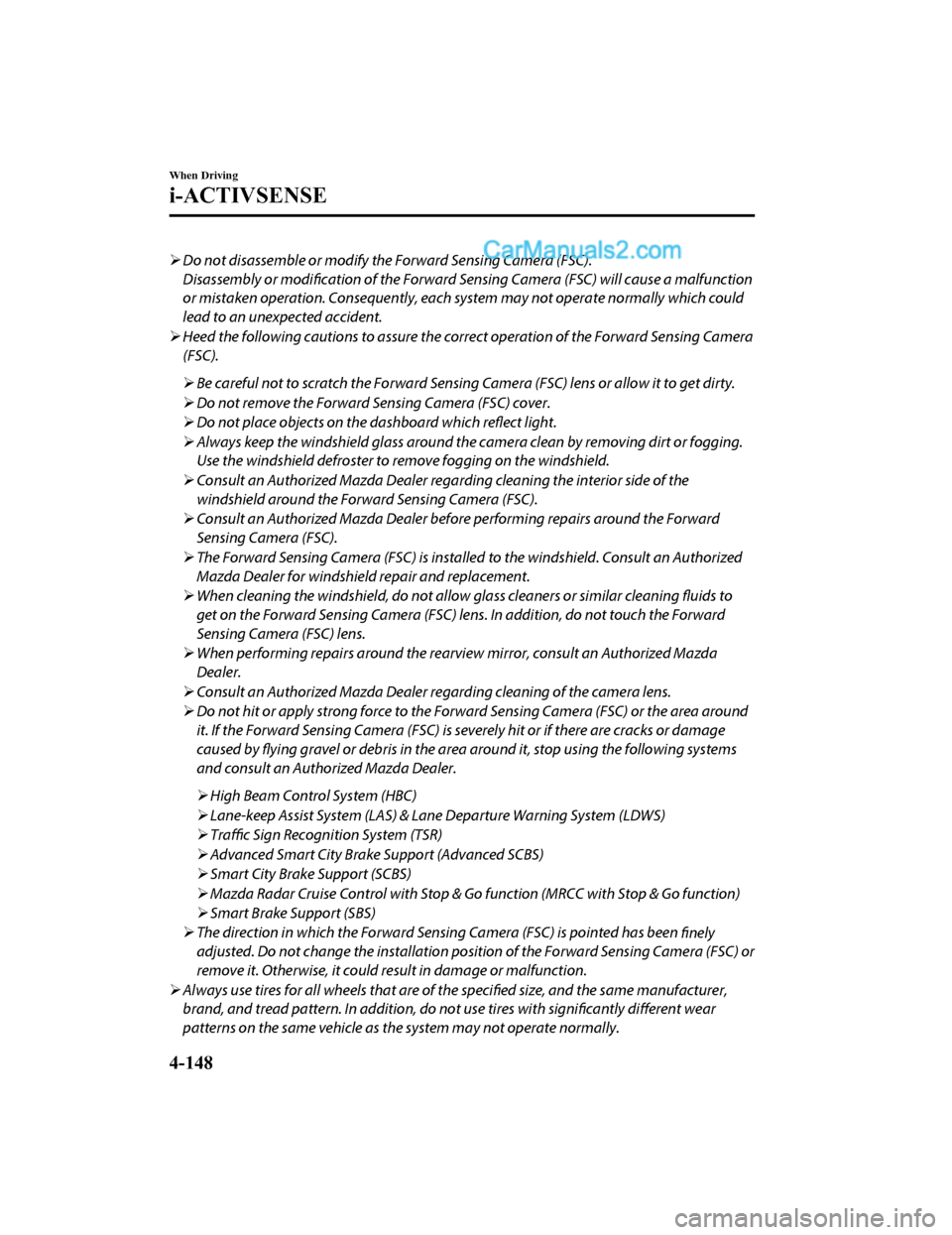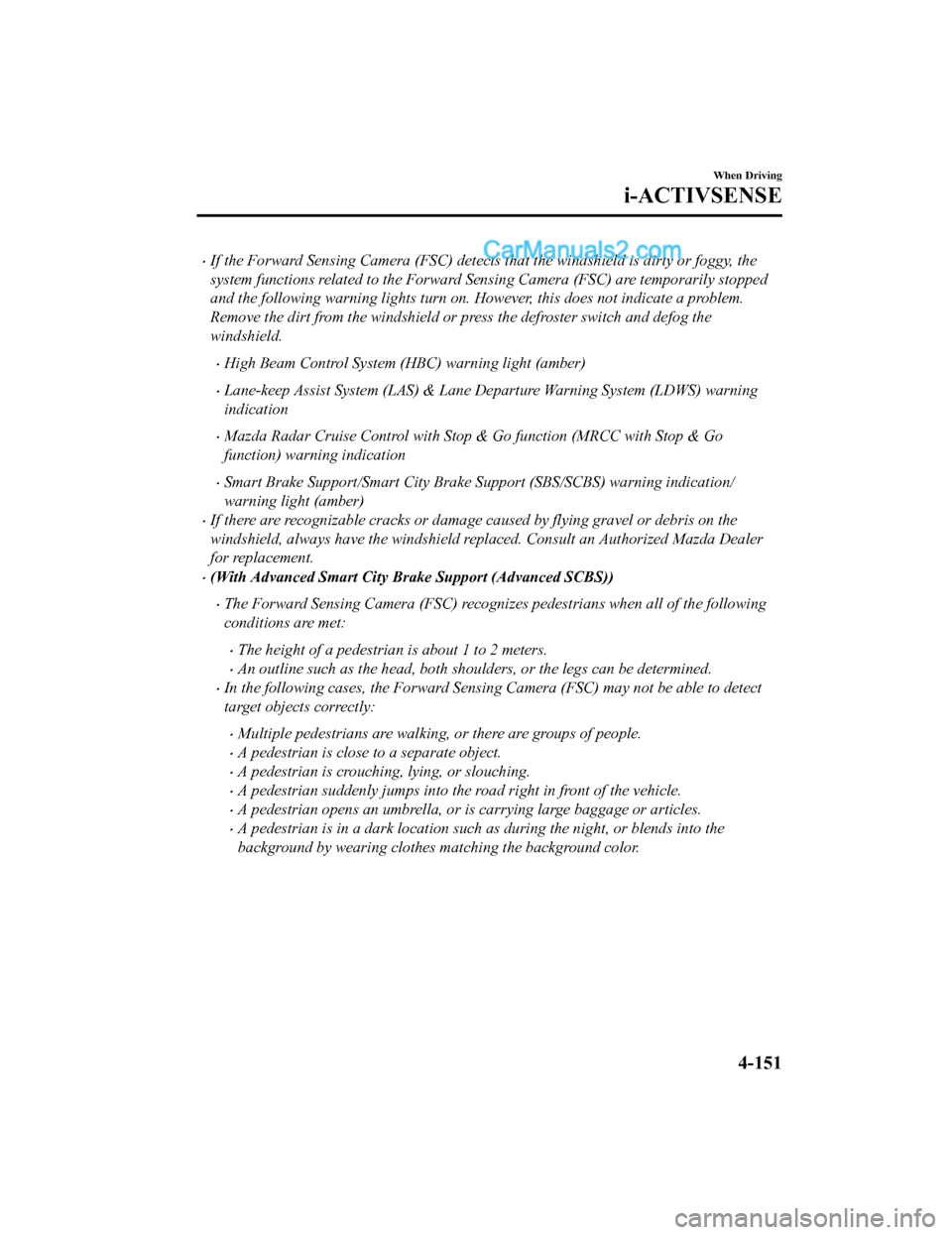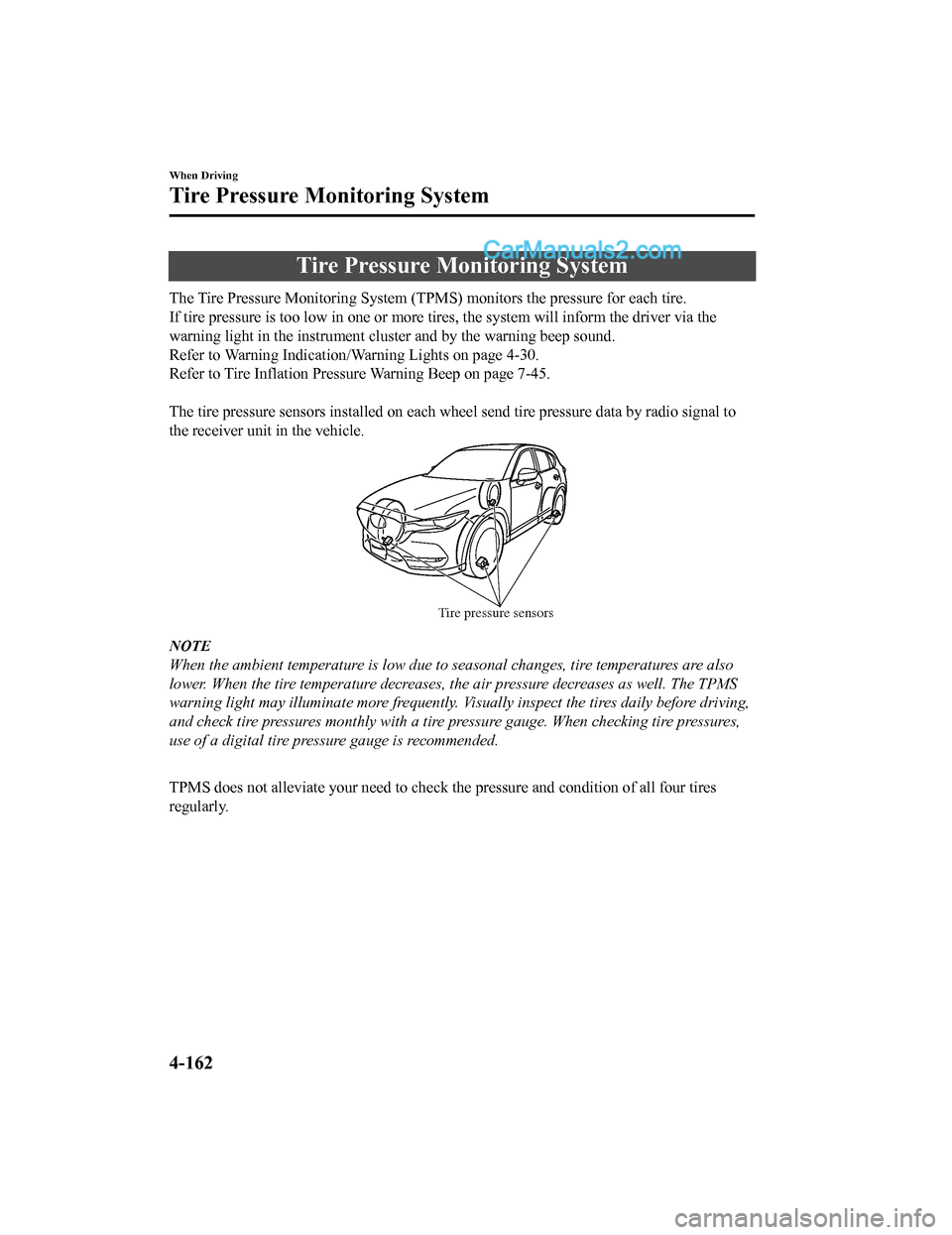warning light MAZDA MODEL CX-5 2018 (in English) Manual PDF
[x] Cancel search | Manufacturer: MAZDA, Model Year: 2018, Model line: MODEL CX-5, Model: MAZDA MODEL CX-5 2018Pages: 628, PDF Size: 82.38 MB
Page 277 of 628

CAUTION
In the following cases, turn the system off to prevent a mis-operation:
’āśThe vehicle is being towed or when towing another vehicle.
’āś The vehicle is on a chassis roller.
’āś When driving on rough roads such as in areas of dense grass or off-road.
Refer to Stopping the Smart Ci ty Brake Support (SCBS) system Operation on page 4-143 on
how to turn off the SCBS system.
NOTE
ŌĆóThe SCBS system will operate under the following conditions.
ŌĆóThe engine is running.
ŌĆóThe Smart Brake Support/Smart City Brake Support (SBS/SCBS) system warning
indication/warning light (amber) does not illuminate.
ŌĆó(Rear-end collision warning)
The vehicle speed is about 4 to 80 km/h (2 to 50 mph).
ŌĆó(Brake control (Smart City Brake Support (SCBS) brake))
The vehicle speed is about 4 to 30 km/h (2 to 18 mph).
ŌĆóThe SCBS system is not turned off.
ŌĆóUnder the following conditions, the SCBS system may not operate normally:
ŌĆóThe SCBS system will not operate if the dr iver is deliberately performing driving
operations (accelerator pedal and steering wheel).
ŌĆóIf there is the possibility of partial contact with a vehicle ahead.
ŌĆóThe vehicle is driven on a slippery road surface such as wet roads or icy or snow-bound
roads.
ŌĆóThe braking performance is adversely affected due to cold temperatures or wet brakes.
ŌĆóThe vehicle is driven at the same speed as the vehicle ahead.
ŌĆóThe accelerator pedal is depressed.
ŌĆóThe brake pedal is depressed.
ŌĆóThe steering wheel is being operated.
ŌĆóThe selector lever is being operated.
ŌĆóIn the following cases, the Forward Sensing Camera (FSC) determines that there is a
vehicle ahead and the SCBS may operate.
ŌĆóObjects on the road at the entrance to a curve.
ŌĆóVehicles passing in the opposite lane while making a curve.
ŌĆóMetal objects, bumps, or protruding objects on the road.
ŌĆóWhen passing through a toll gate.
ŌĆóWhen passing through low gates, narrow gates, car washing machines, or tunnels.
When Driving
i-ACTIVSENSE
4-141
CX-5_8GN5-EA-17J_Edition1 2017-8-18 12:58:27
Page 278 of 628

ŌĆóIf you suddenly come close to a vehicle ahead.
ŌĆó2-wheeled vehicles, pedestrians, animals or standing trees.
ŌĆóVehicle is driven with some of the tires having significant wear.
Ō¢╝Smart City Brake Support (SCBS)
Indicator Light (Red)
If the Smart City Brake Support (SCBS) is
operating, the indicator light (red) flashes.
Ō¢╝Collision Warning
If there is the possibil
ity of a collision with
a vehicle ahead, the beep sounds
continuously and a warning is indicated in
the multi-information d isplay or the active
driving display.
Multi-information Display
Active Driving Display
NOTE
The operation distance and volume of the
collision warning can be changed. Refer
to Personalization Features on page 9-
9.
Ō¢╝ Automatic Brake
Operation Display
The automatic brake operation display is
indicated on the multi-information display
after the SCBS is operated.
NOTE
ŌĆóThe collision warning beep sounds
intermittently while the SCBS brake or
brake assist (SCBS brake assist) is
operating.
ŌĆóIf the vehicle is stopped by the SCBS
operation and the brake pedal is not
depressed, the warning beep sounds one
time after about 2 seconds and the SCBS
brake is automatically released.
When Driving
i-ACTIVSENSE
4-142
CX-5_8GN5-EA-17J_Edition1 2017-8-18 12:58:27
Page 281 of 628

ŌĆóThe SBS system may not operate under the following conditions:
ŌĆóIf the vehicle is accelerated rapidly and it comes cl ose to a vehicle ahead.
ŌĆóThe vehicle is driven at the same speed as the vehicle ahead.
ŌĆóThe accelerator pedal is depressed.
ŌĆóThe brake pedal is depressed.
ŌĆóThe steering wheel is being operated.
ŌĆóThe selector lever is being operated.
ŌĆóThe turn signal is being used.
ŌĆóWhen the vehicle ahead is not equipped with taillights or the taillights are turned off.
ŌĆóWhen warnings and messages, such as a dirty windshield, related to the Forward
Sensing Camera (FSC) are being displa yed in the multi-information display.
ŌĆóAlthough the objects which activate the syst em are four-wheeled vehicles, the radar
sensor (front) could detect the following objects, determine them to be an obstruction, and
operate the SBS system.
ŌĆóObjects on the road at the entrance to a curve (including guardrails and snow banks).
ŌĆóA vehicle appears in the opposite lane while cornering or rounding a curve.
ŌĆóWhen crossing a narrow bridge.
ŌĆóWhen passing under a low gate or through a tunnel or narrow gate.
ŌĆóWhen entering an underground parking area.
ŌĆóMetal objects, bumps, or protruding objects on the road.
ŌĆóIf you suddenly come close to a vehicle ahead.
ŌĆóWhen driving in areas where there is high grass or forage.
ŌĆóTwo-wheeled vehicles such as motorbikes or bicycles.
ŌĆóPedestrians or non-metallic objects such as standing trees.
ŌĆóWhen the system operates, the user is no tified by the multi-information display.
ŌĆóThe SBS warning indication (amber) turn s on when the system has a malfunction.
Refer to Warning Indication/Warning Lights on page 4-30.
When Driving
i-ACTIVSENSE
4-145
CX-5_8GN5-EA-17J_Edition1 2017-8-18 12:58:27
Page 282 of 628

Ō¢╝Collision Warning
If there is the possibil
ity of a collision with
a vehicle ahead, the beep sounds
continuously and a warning is indicated in
the multi-informati on display and the
active driving display.
Multi-information Display
Active Driving Display
Ō¢╝ Stopping The Smart Brake Support
(SBS) System Operation
The SBS system can be temporarily
deactivated.
Refer to Personalizat
ion Features on page
9-9.
When the SBS system is turned off, the
SBS OFF indicator light turns on.
When the engine is restarted, the system
becomes operational.
NOTE
If the SBS system operation is turned off,
the Smart City Brake Support (SCBS)
system operation is turned off
simultaneously.
When Driving
i-ACTIVSENSE
4-146
CX-5_8GN5-EA-17J_Edition1 2017-8-18 12:58:27
Page 284 of 628

’āśDo not disassemble or modify the Forward Sensing Camera (FSC).
Disassembly or modification of the Forward Sensing Camera (FSC) will cause a malfunction
or mistaken operation. Consequently, each sy stem may not operate normally which could
lead to an unexpected accident.
’āś Heed the following cautions to assure the correct operation of the Forward Sensing Camera
(FSC).
’āś Be careful not to scratch the Forward Sensing Camera (FSC) lens or allow it to get dirty.
’āś Do not remove the Forward Sensing Camera (FSC) cover.
’āś Do not place objects on the dashboard which reflect light.
’āś Always keep the windshield glass around the camera clean by removing dirt or fogging.
Use the windshield defroster to remove fogging on the windshield.
’āś Consult an Authorized Mazda Dealer regardi ng cleaning the interior side of the
windshield around the Forw ard Sensing Camera (FSC).
’āś Consult an Authorized Mazda Dealer before performing repairs around the Forward
Sensing Camera (FSC).
’āś The Forward Sensing Camera (FSC) is installe d to the windshield. Consult an Authorized
Mazda Dealer for windshield repair and replacement.
’āś When cleaning the wind shield, do not allow glass cleaners or similar cleaning fluids to
get on the Forward Sensing Camera (FSC) le ns. In addition, do not touch the Forward
Sensing Camera (FSC) lens.
’āś When performing repairs around the rearv iew mirror, consult an Authorized Mazda
Dealer.
’āś Consult an Authorized Mazda Dealer regarding cleaning of the camera lens.
’āś Do not hit or apply strong force to the Forward Sensing Camera (FSC) or the area around
it. If the Forward Sensing Camera (FSC) is severely hit or if there are cracks or damage
caused by flying gravel or debris in the area around it, stop using the following systems
and consult an Authorized Mazda Dealer.
’āś High Beam Control System (HBC)
’āś Lane-keep Assist System (LAS) & Lane Departure Warning System (LDWS)
’āś Traffic Sign Recognition System (TSR)
’āś Advanced Smart City Brak e Support (Advanced SCBS)
’āś Smart City Brake Support (SCBS)
’āś Mazda Radar Cruise Control with Stop & Go function (MRCC with Stop & Go function)
’āś Smart Brake Support (SBS)
’āś The direction in which the Forward Sensing Camera (FSC) is pointed has been
finely
adjusted. Do not change the installation posi tion of the Forward Sensing Camera (FSC) or
remove it. Otherwise, it could result in damage or malfunction.
’āś Always use tires for all wheels that are of the specified size, and the same manufacturer,
brand, and tread pattern. In addition, do no t use tires with significantly different wear
patterns on the same vehicle as the system may not operate normally.
When Driving
i-ACTIVSENSE
4-148
CX-5_8GN5-EA-17J_Edition1 2017-8-18 12:58:27
Page 286 of 628

ŌĆóThe surroundings are dark such as during the night, early evening, or early morning, or
in a tunnel or indoor parking lot.
ŌĆóThe illumination brightness of the headlights is reduced or the headlight illumination is
weakened due to dirt or a deviated optical axis.
ŌĆóThe target object enters the blind spot of the Forward Sensing Camera (FSC).
ŌĆóA person or object bursts onto the road from the shoulder or cuts right in front of you.
ŌĆóYou change lanes and approach a vehicle ahead.
ŌĆóWhen driving extremely close to the target object.
ŌĆóTire chains or a temporary spare tire is installed.
ŌĆóThe vehicle ahead has a special shape. For example, a vehicle towing a trailer house or
a boat, or a vehicle carrier carrying a vehicle with its front pointed rearward.
ŌĆóIf the Forward Sensing Camera (FSC) cannot operate normally due to backlight or fog,
the system functions related to the Forward Sensing Camera (FSC) are temporarily
stopped and the following warn ing lights turn on. However, this does not indicate a
malfunction.
ŌĆóHigh Beam Control System (HBC) warning light (amber)
ŌĆóLane-keep Assist System (LAS) & Lane Departure Warning System (LDWS) warning
indication
ŌĆóMazda Radar Cruise Control with Stop & Go function (MRCC with Stop & Go
function) warning indication
ŌĆóSmart Brake Support/Smart City Brake Support (SBS/SCBS) warning indication/
warning light (amber)
ŌĆóIf the Forward Sensing Camera (FSC) cannot operate normally due to high temperatures,
the system functions related to the Forward Sensing Camera (FSC) are temporarily
stopped and the following warn ing lights turn on. However, this does not indicate a
malfunction. Cool down the area around the Forward Sensing Camera (FSC) such as by
turning on the air conditioner.
ŌĆóHigh Beam Control System (HBC) warning light (amber)
ŌĆóLane-keep Assist System (LAS) & Lane Departure Warning System (LDWS) warning
indication
ŌĆóMazda Radar Cruise Control with Stop & Go function (MRCC with Stop & Go
function) warning indication
ŌĆóSmart Brake Support/Smart City Brake Support (SBS/SCBS) warning indication/
warning light (amber)
When Driving
i-ACTIVSENSE
4-150
CX-5_8GN5-EA-17J_Edition1 2017-8-18 12:58:27
Page 287 of 628

ŌĆóIf the Forward Sensing Camera (FSC) detects that the windshield is dirty or foggy, the
system functions related to the Forward Sensing Camera (FSC) are temporarily stopped
and the following warning lights turn on. However, this does not indicate a problem.
Remove the dirt from the windshield or press the defroster switch and defog the
windshield.
ŌĆóHigh Beam Control System (HBC) warning light (amber)
ŌĆóLane-keep Assist System (LAS) & Lane Departure Warning System (LDWS) warning
indication
ŌĆóMazda Radar Cruise Control with Stop & Go function (MRCC with Stop & Go
function) warning indication
ŌĆóSmart Brake Support/Smart City Brake Support (SBS/SCBS) warning indication/
warning light (amber)
ŌĆóIf there are recognizable cracks or damage caused by flying gravel or debris on the
windshield, always have the windshield replaced. Consult an Authorized Mazda Dealer
for replacement.
ŌĆó(With Advanced Smart City Brake Support (Advanced SCBS))
ŌĆóThe Forward Sensing Camera (FSC) recognizes pedestrians when all of the following
conditions are met:
ŌĆóThe height of a pedestrian is about 1 to 2 meters.
ŌĆóAn outline such as the head, both shoulders, or the legs can be determined.
ŌĆóIn the following cases, the Forward Sensing Camera (FSC) may not be able to detect
target objects correctly:
ŌĆóMultiple pedestrians are walking, or there are groups of people.
ŌĆóA pedestrian is close to a separate object.
ŌĆóA pedestrian is crouching, lying, or slouching.
ŌĆóA pedestrian suddenly jumps into the road right in front of the vehicle.
ŌĆóA pedestrian opens an umbrella, or is carrying large baggage or articles.
ŌĆóA pedestrian is in a dark location such as during the night, or blends into the
background by wearing clothes matching the background color.
When Driving
i-ACTIVSENSE
4-151
CX-5_8GN5-EA-17J_Edition1 2017-8-18 12:58:27
Page 298 of 628

Tire Pressure Monitoring System
The Tire Pressure Monitoring System (TPMS) monitors the pressure for each tire.
If tire pressure is to o low in one or more tires, the system will inform the driver via the
warning light in the instrument cluster and by the warning beep sound.
Refer to Warning Indication/Warning Lights on page 4-30.
Refer to Tire Inflation Pressu re Warning Beep on page 7-45.
The tire pressure sensors installed on each wheel send tire pre ssure data by radio signal to
the receiver unit in the vehicle.
Tire pressure sensors
NOTE
When the ambient temperature is low due to seasonal changes, tire temperatures are also
lower. When the tire temperature decreases, the air pressure decreases as well. The TPMS
warning light may illumina te more frequently. Visually inspect the tires daily before driving,
and check tire pressures monthly with a tire pressure gauge. When checking tire pressures,
use of a digital tire pressure gauge is recommended.
TPMS does not alleviate your need to check the pressure and con dition of all four tires
regularly.
When Driving
Tire Pressure Monitoring System
4-162
CX-5_8GN5-EA-17J_Edition1 2017-8-18 12:58:27
Page 300 of 628

Ō¢╝System Error Activation
When the warning light flashes, there may
be a system malfunction. Consult an
Authorized Mazda Dealer.
A system error activation may occur in the
following cases:
ŌĆóWhen there is equipment or a device
near the vehicle using the same radio
frequency as that of the tire pressure
sensors.
ŌĆóWhen a metallic device such as a
non-genuine navigation system is
equipped near the center of the
dashboard, which may block radio
signals from the tire pressure sensor to
the receiver unit.
ŌĆóWhen using the following devices in the
vehicle that may cause radio
interference with the receiver unit.
ŌĆóA digital device such as a personal
computer.
ŌĆóA current converter device such as a
DC-AC converter.
ŌĆóWhen excess snow or ice adheres to the
vehicle, especially around the wheels.
ŌĆóWhen the tire pressu
re sensor batteries
are exhausted.
ŌĆóWhen using a wheel with no tire
pressure sensor installed.
ŌĆóWhen using tires with steel wire
reinforcement in the side walls.
ŌĆóWhen using tire chains.
Ō¢╝ Tires and Wheels
CAUTION
When inspecting or adjusting the tire air
pressures, do not apply excessive force to
the stem part of the wheel unit. The stem
part could be damaged.
Changing tires and wheels
The following procedure allows the TPMS
to recognize a tire pressure sensor's unique
ID signal code whenever tires or wheels
are changed, such as changing to and from
winter tires.
NOTE
Each tire pressure sensor has a unique ID
signal code. The signal code must be
registered with the TPMS before it can
work. The easiest way to
do it is to have
an Authorized Mazda Dealer change your
tire and complete ID signal code
registration.
When having tires changed at an
Authorized Mazda Dealer
When an Authorized Mazda Dealer
changes your vehicle's tires, they will
complete the tire pressure sensor ID signal
code registration.
When changing tires yourself
If you or someone else changes tires, you
or someone else can also undertake the
steps for the TPMS to complete the ID
signal code registration.
1. After tires have been changed, switch
the ignition ON, then back to ACC or
OFF.
2. Wait for about 15 minutes.
When Driving
Tire Pressure Monitoring System
4-164
CX-5_8GN5-EA-17J_Edition1 2017-8-18 12:58:27
Page 301 of 628

3. After about 15 minutes, drive thevehicle at a speed of at least 25 km/h
(16 mph) for 10 minutes and the tire
pressure sensor ID s ignal code will be
registered automatically.
NOTE
If the vehicle is driven within about 15
minutes of changing tires, the tire pressure
monitoring system warning light will flash
because the sensor ID signal code would
not have been registered. If this happens,
park the vehicle fo r about 15 minutes,
after which the sensor ID signal code will
register upon driving the vehicle for 10
minutes.
Replacing tires and wheels
CAUTION
’āś When replacing/repairing the tires or
wheels or both, have the work done by
an Authorized Mazda Dealer, or the tire
pressure sensors may be damaged.
’āś The wheels equipped on your Mazda are
specially designed for installation of the
tire pressure sensors. Do not use
non-genuine wheels, otherwise it may
not be possible to install the tire pressure
sensors.
Be sure to have the tire pressure sensors
installed whenever tires or wheels are
replaced.
When having a tire or wheel or both
replaced, the following types of tire
pressure sensor installations are possible.
ŌĆóThe tire pressure sensor is removed
from the old wheel and installed to the
new one.
ŌĆóThe same tire pressu re sensor is used
with the same wheel. Only the tire is
replaced.
ŌĆóA new tire pressure sen sor is installed to
a new wheel.
NOTE
ŌĆóThe tire pressure sensor ID signal code
must be registered when a new tire
pressure sensor is purchased. For
purchase of a tire pressure sensor and
registration of the tire pressure sensor
ID signal code, consult an Authorized
Mazda Dealer.
ŌĆóWhen reinstalling a previously removed
tire pressure sensor to a wheel, replace
the grommet (seal between valve body/
sensor and wheel) for the tire pressure
sensor.
When Driving
Tire Pressure Monitoring System
4-165
CX-5_8GN5-EA-17J_Edition1 2017-8-18 12:58:27